There are twenty seven (27) good companion plants for basil and six (6) bad in this list.
Reasons why they are or are not ideal beside your plant, are also explained.
Basil (Ocimum basilicum) is a member of the Lamiaceae family of culinary herbs (mints).
It is also known as sweet Basil or Great Basil. It is a delicate plant that is used in cuisines all over the world.
Depending on the variety, Basil has a different taste. But most of all, the Basil varieties have a somewhat peppery and minty flavor.
Basil is a herb that is usually annual but may also be perennial.
Although the leaves are oval and have a deep green color, each species’ leaves can vary significantly in size and form.
The dimensions of a leaf are between 1 and 6 cm (½ and 2 ½ in) broad and 3 to 11 cm (1 to 4 ½ in) long, and they are usually between 30 and 150 cm tall. Most basils are sweet basil varieties.
While the majority of basil types have green leaves, others, like “Purple Delight,” have purple ones.
Basil is one of several plants whose blossoms and leaves can both be eaten.
Fresh Basil is most frequently used in cooking. It is often added last since cooking quickly alters the taste. After gently blanching in boiling water, the fresh herb can be kept in plastic bags in the refrigerator for a short period or in the freezer for a longer time.
Basil grows best in hot, dry conditions and is susceptible to cold. If there is even a little likelihood of a frost, it acts like an annual.
There are various plant infections and pests that affect Basil.
Younger basil plants will die quickly from the soil-borne fungal disease known as fusarium wilt.
The seedlings can also wilt off quickly when affected by Pythium damping off. Pests such as Japanese beetles, snails, and aphids can harm the plant too.
Basil may be grown in the Garden with a number of other plants that could help it flourish, prevent pests, draw beneficial insects to it, enrich the soil with nutrients, function as ground cover, or protect it from too much sunshine.
In addition to these benefits, growing these plants will make better use of your garden space, allowing you to cultivate more plants in a given area.
And this mutual benefit between Basil and other plants is termed Companion planting.
Table of Contents
Good Companion Plants for Basil
1. Asparagus

Asparagus belongs to the subfamily Asparagoideae of the Asparagaceae family of flowering plants.
It is a common vegetable that is frequently prepared and served as a side dish.
Aphids are one of the most harmful pests for Basil and may be avoided by planting asparagus close to your basil plant.
Basil plants are protected by asparagus because it draws ladybugs, which aid with aphid control.
The basil plants are shaded by asparagus, which keeps them cool and shields them from strong winds.
And In turn, Basil aids in warding off the asparagus beetle, which damages the roots of the asparagus plant.
Therefore, placing it next to asparagus will significantly help that plant’s growth.
2. Beans

A bean is the seed of one of the numerous genera of the Fabaceae flowering plant family, which are grown for human and animal consumption as vegetables.
Beans are a good source of iron, folate, complex carbs, and protein.
Bean plants are a great supplier of nitrogen; through a process known as nitrogen fixation, beans assist your basil plant get the necessary quantity of nitrogen by storing it in the soil.
This makes them ideal for growing alongside Basil. And your Basil will also greatly benefit from all the extra nutrients, becoming big and lush as a result.
Your Basil also enhances bean productivity by discouraging Mexican bean bugs, which can damage the beans.
3. Beets
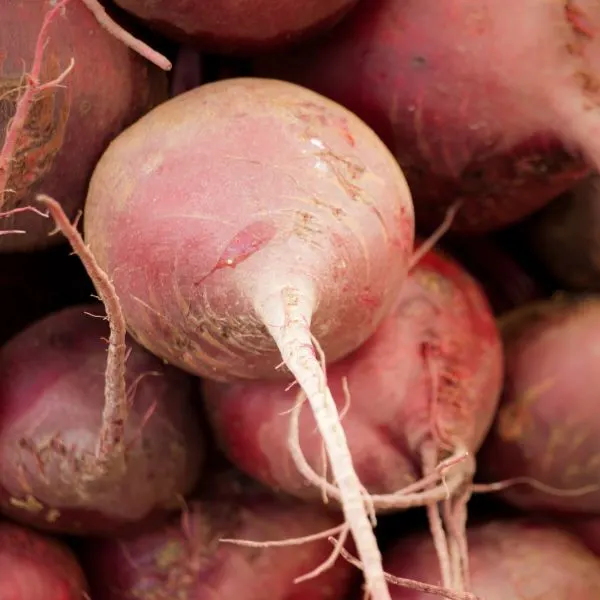
Beetroot, more often known as beets, and beetroot are excellent companion plants for Basil.
They are blooming plants that produce an edible taproot that is usually deep red and has a flavor that is a little harsh and earthy.
These plants’ leaves can also be cooked and consumed as vegetables.
Beets work well as a trap crop to keep pests that consume Basil away from your basil area.
As a result, it makes a great companion plant for your Bail.
The pest-repelling scents from your basil plants also help the beets’ leafy green tops.
4. Borage

Borage, often known as starflower, is an annual herb in the Boraginaceae flowering plant family.
The leaves of borage can be consumed fresh or dried as a vegetable or herb.
It works to prevent pests like tomato hornworms that are damaging to Basil’s other companions.
It not only helps your Basil grow and taste better when grown alongside it, but it’s also one of the finest plants for luring pollinators like bees.
Borage may also draw out a number of essential minerals from the soil, and Once these minerals are closer to the surface, companion plants, like your Basil, may utilize them to enhance their development and vitality.
5. Carrot

The carrot is a biennial root vegetable that is usually orange in color and belongs to the Apiaceae genus of umbellifers.
The taproot of the plant is the component that is most frequently consumed; however, the stems and leaves are also consumed.
Basil may enhance the development and flavor of carrots; thus, they make an excellent match for each other.
Basil plants may be utilized as a natural pest control method since their aroma can scare away soil bugs.
Extremely common soil-boring insects are seen on the leafy green tops of the root crops.
6. Cauliflower
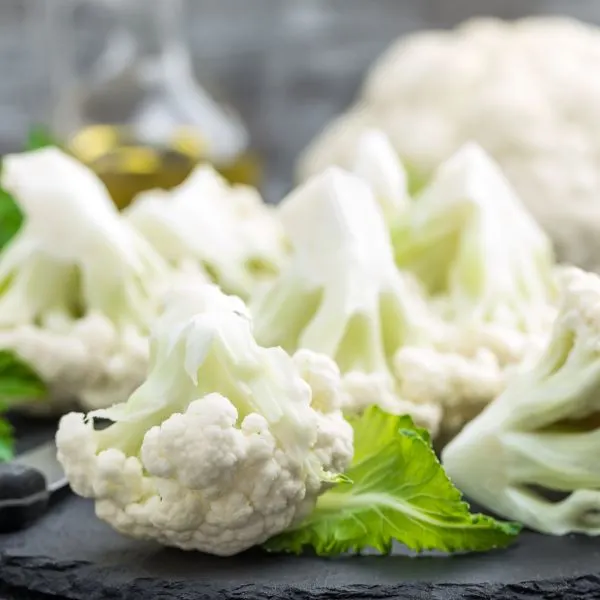
Cauliflower is a vegetable plant that belongs to the Brassicaceae family. Ideally, only the plant’s head should be consumed because it is the edible part of the plant, which consists of fleshy stalks and partially grown blooms.
White is its most popular color. Various cuisines use cauliflower prepared in a variety of ways, including boiling, frying, grilling, pickling, and steaming.
Cauliflower and Basil go well together because Basil draws important insects to your yard.
This plant attracts butterflies and a variety of other insects that help with pollination or consume hazardous crop pests.
Basil not only attracts beneficial insects to your cauliflower plant but also repels a number of destructive insects.
Basil prevents aphids from attacking cauliflower, which they are known to do. Additionally, it keeps white flies, hornworms, and beetles away from other plants.
7. Chamomile
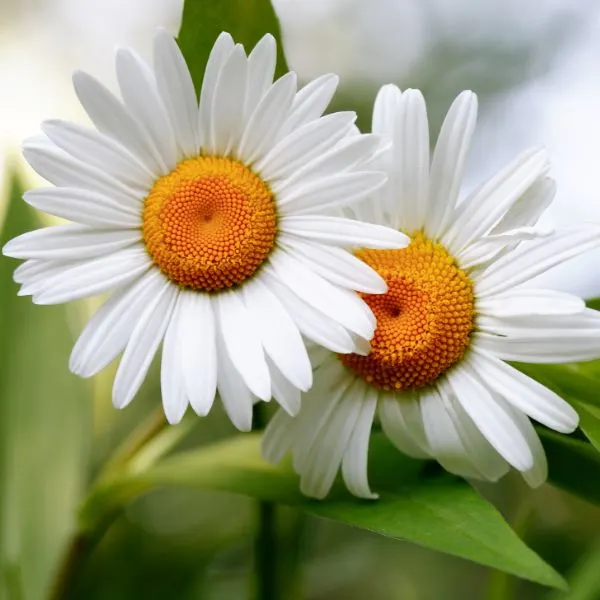
Chamomile is the common name for a group of daisy-like plants of the Asteraceae family. You may flavor dishes and drinks, mouthwash, and soaps with chamomile.
Chamomile may be planted next to your basil plant to boost the potency of its essential oils.
This enhances the flavor of your Basil in food preparations and increases its effectiveness as a pest-repellent in your Garden.
Furthermore, since German chamomile and Basil are both summer annuals, you may plant them simultaneously, and they will thrive together.
Use an already-grown herb when adding chamomile to your basil container. This facilitates the procedure and helps you save time.
8. Chilies
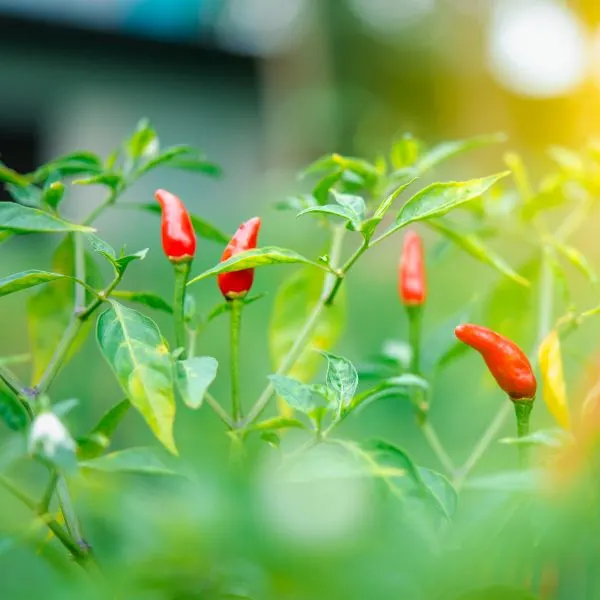
Chili peppers are several kinds of berry-fruit produced by plants belonging to the Solanaceae (nightshade family) genus Capsicum.
Chili peppers are frequently used as a spice to impart “heat” to foods in many different cuisines. The remarkable thing about chili plants is the contrast in look and color.
Basil and chilies grow well together. Basil enhances the flavor of peppers when grown next to them.
Additionally, it aids in the warding off of several common garden pests, including aphids, spider mites, thrips, mosquitoes, and flies.
Basil is twice as efficient at keeping garden pests away from chili plants as it covers up bare ground.
Remember that Basil helps to hold heat and moisture in, whereas peppers enjoy dampness.
They are, therefore, excellent for companion planting.
9. Chives

Chives are a flowering plant in the Amaryllidaceae family with edible flowers and leaves. Chives are a popular herb that may be cultivated in home gardens for both decorative and culinary purposes.
Another flavorful herb that goes well with Basil is chives. In addition to enhancing the flavor of your Basil, it also helps to ward against insect pests like aphids.
They make your basil taste better and work better as a pest deterrent, and produce more of the herb Basil’s essential oils.
Growing them together can also add a nice taste boost to your food.
10. Cilantro

Cilantro belongs to the Apiaceae family and is an annual. It also goes by the name coriander.
All plant components, save the fresh leaves and the dried seeds, are edible.
The fresh leaves are frequently used as a garnish for soup, fish, and meat dishes and as a component in chutneys, salads, salsa, and guacamole.
The same conditions are favorable for producing both Basil and cilantro.
Due to their shared ability to ward off common insect pests like beetles and aphids, they also provide additional defense for your other companion plants.
Additionally, this plant stimulates essential oils that are good for your basil plants.
11. Broccoli

Broccoli is an edible green plant from the cabbage family (family Brassicaceae, genus Brassica), whose enormous flowering head, stem, and tiny accompanying leaves are consumed as a vegetable.
It may be consumed fresh or prepared using stir-frying, steaming, and microwaving.
Basil is a good companion plant for broccoli because it deters pest insects like the white cabbage moth with its fragrant perfume, especially In the summer when the broccoli plants are still young and the cabbage moth is quite active in the Garden.
12. Eggplant
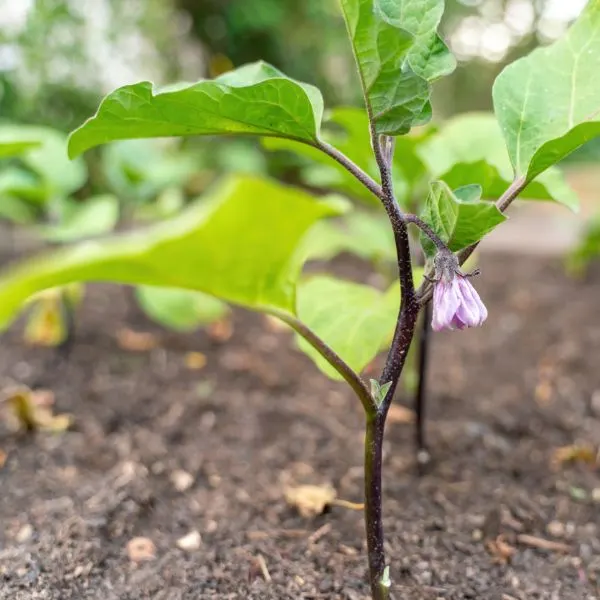
Eggplant is a species of the nightshade family Solanaceae. It is used in cooking as a vegetable.
It is possible to steam, stir-fry, pan-fry, deep-fry, barbeque, roast, stew, curry, or pickle eggplant.
Specifically, mealybugs, garden moths, and aphids are likely to attack eggplants.
However, they are shielded from this attack when planted alongside basils because of the latter’s strong insect-repellent smell.
This will result in greater output and enable you to add Basil to any meal needed for eggplant, encouraging the plant to produce additional fruit.
The needs of Basil apply to eggplants as well.
13. Garlic
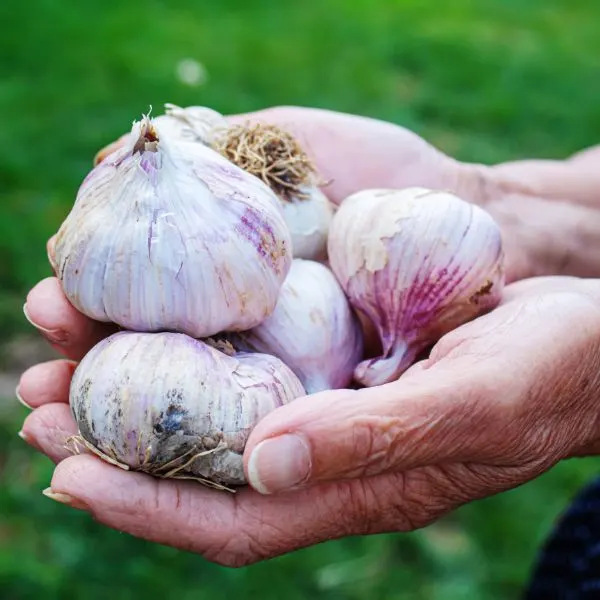
Garlic is a bulbous blooming plant, An example of an Allium species; garlic plants are hardy plants, typically resilient and unaffected by many pests or diseases.
In order to direct all of the garlic’s energy toward bulb growth, the scapes are cut off.
You may consume the scapes either raw or cooked.
When you grow Basil and garlic together, your basil patch will be much healthier.
Both of these plants aid in the prevention of spider mites, aphids, and whiteflies, resulting in much better harvests.
Basil and garlic are said to enhance one another’s flavors as well.
Don’t crowd these plants; give them adequate room to spread out and flourish.
Additionally, certain animals, like squirrels and rabbits, can be deterred by garlic.
14. Grapes

A grape is a fruit, technically a berry, of the woody, deciduous vines that belong to the genus Vitis of flowering plants.
Grapes are a sort of fruit that can be red, black, dark blue, yellow, green, orange, or pink. They typically grow in clusters of 15 to 300.
Grape production is increased when Basil is grown next to your grape plants.
Numerous pests like visiting grape plants and eating fruit. Basil’s ability to repel insects is very helpful to grapes for that.
15. Lavender
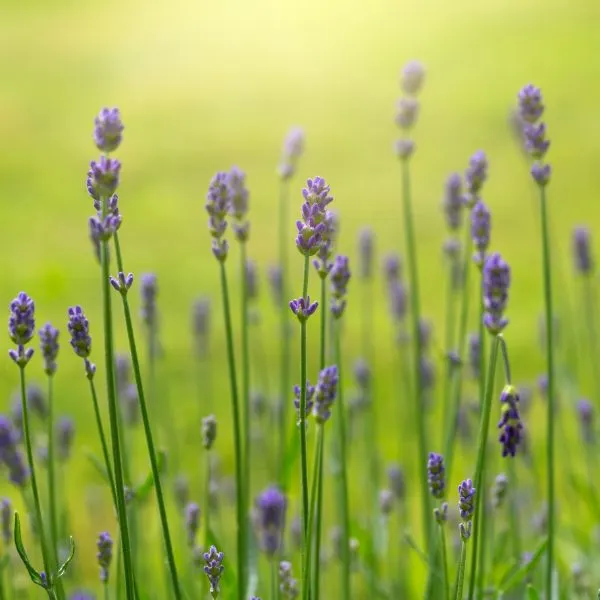
Lavandula, popularly known as lavender, is a genus of flowering plants in the Lamiaceae (mint family).
The dried buds, which are also known as flowers, are utilized in most cooking applications, and When compared to rosemary, the flavor of lavender leaves is milder.
Basil helps to repel aphids and other flying insects, making it the ideal plant to grow with lavender.
Lavender, on the other hand, draws helpful insects like bees.
16. Lemon grass

Lemongrass is a genus of tropical island plants in the grass family, also known as Cymbopogon or fever grass.
These species are used to make citronella oil, which is used in soaps, candles, insect sprays, and aromatherapy.
It is particularly effective in keeping mosquitoes and houseflies away.
The same ideal growth conditions—full light and well-drained soil—are enjoyed by both lemongrass and Basil.
These attributes make it a suitable Basil partner.
17. Marigold
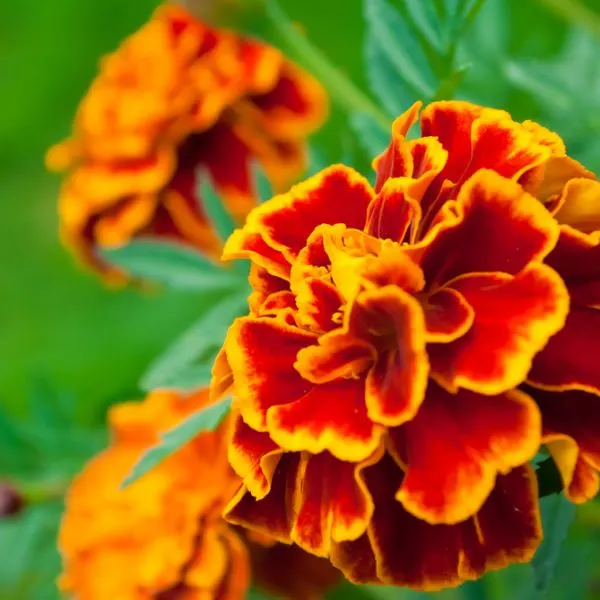
Marigold belongs to the Asteraceae family, generally known as the Tagetes family, and is composed primarily of annual or perennial herbaceous plants.
t has been used as a flavoring agent in food and as a source of the essential oil known as marigold oil.
Planting marigolds and Basil together will create a powerful scented barrier that naturally repels insects.
Marigolds are regarded as one of the greatest companion plants for the vegetable garden, along with Basil.
They aid in the prevention of a number of unfriendly pests, including nematodes, snails, Japanese beetles, and aphids.
Hoverflies, ladybugs, and parasitic wasps are just a few helpful insects drawn to marigolds.
Therefore, growing marigolds and Basil in your food garden provides your plants with additional protection from pests.
Additionally, marigolds are thought to help your basil taste better.
Just be careful to select a low-growing marigold kind so that they don’t grow excessively quickly and smother the Basil.
Grow French marigolds rather than Mexican ones as well.
The Mexican variety’s roots release a potent toxin that can inhibit the development of Basil and other surrounding plants.
The basil plants and marigold blooms need to be separated by plenty of space.
Marigolds should not be overwatered since they might decay in moist soil.
18. Marjoram
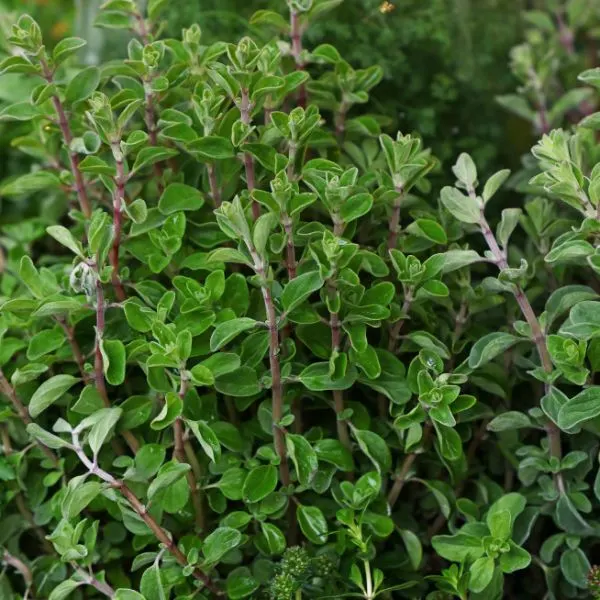
Marjoram is a perennial plant or undershrub with citrus and pine flavors that are sensitive to cold.
Marjoram is grown for its flavorful leaves, which can be used fresh or dried in cooking.
As a medicinal herb, marjoram is also used to flavor herbal teas, soups, stews, salad dressings, sauces, and other foods.
Marjoram makes an excellent basil companion plant, Due to its ability to ward off pest insects like aphids, spider mites, and whiteflies.
Additionally, it serves as a wonderful attraction for pollinators like bees and butterflies. Marjoram is also said to enhance the flavor of Basil.
Marjoram is a very nice companion plant for your Basil since it can flourish in the same conditions as your Basil and grow there as well.
19. Oregano

Oregano is a flowering plant of the Lamiaceae mint family.
The flavor of oregano leaves, which are used in cooking, might be stronger when dried than when they are fresh.
Like many other aromatic herbs, oregano aids Basil in keeping annoying bug pests out of your Garden.
Additionally, it improves the flavor of your Basil. Additionally, when oregano is in bloom, it might draw beneficial insects.
Oregano may be cultivated as a perennial in many gardens.
This means you may substitute another plant that grows peacefully with this fragrant herb for the Basil after its growing season.
20. Parsley
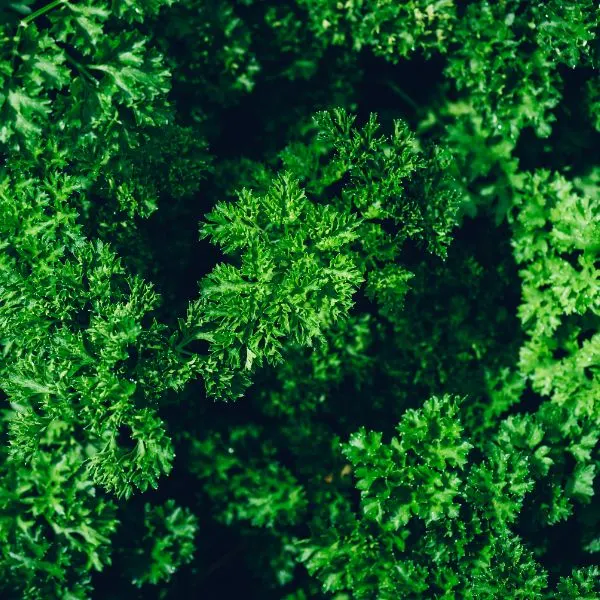
Parsley, also known as garden parsley, is a species of flowering plant belonging to the Apiaceae family.
American cuisine frequently uses parsley.
Green parsley is commonly used as a garnish on potato dishes, goose, rice dishes, fried chicken, fish, lamb, and steaks, as well as in meat or vegetable stews.
Basil and parsley both benefit from similar soil conditions for growth, and both plants require enough moisture in the soil to prosper.
Asparagus beetles and nematodes may both be repelled by parsley, which also enhances the flavor of your Basil.
Additionally, when planted together as companion plants for other plants, such as asparagus and brassicas, Basil and parsley have a greater effect.
21. Parsnip

The root vegetable parsnip is related to the vegetables carrot and parsley and is also a member of the Apiaceae family of flowering plants.
While parsnips and carrots are similar in appearance and can be used in similar ways, they taste sweeter, especially when cooked.
They can be roasted, fried, grilled, baked, boiled, pureed, or steam-cooked.
They provide a deep flavor to stews, soups, and casseroles.
When parsley blooms set seed, they will draw predatory insects that feed on bugs that eat Basil.
Parsnip roots also exude a poisonous chemical that repels aphids and spider mites.
22. Bell peppers
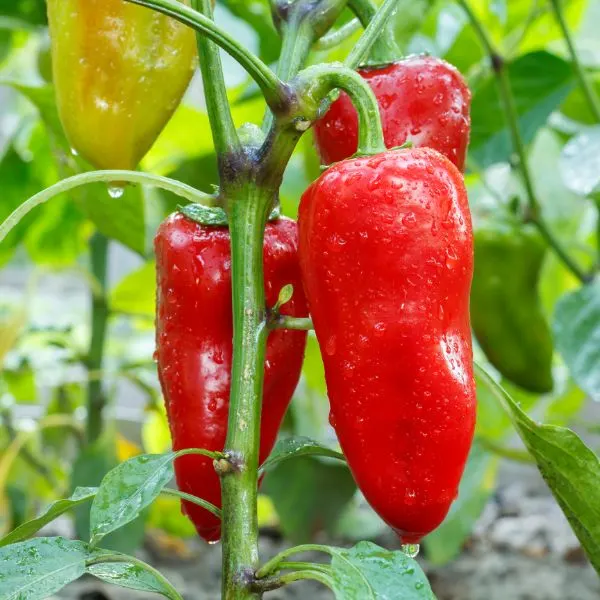
The bell pepper, which is also referred to as paprika, sweet pepper, pepper, or capsicum, is the fruit of plants belonging to the Grossum Group that belong to the species Capsicum annuum.
Bell peppers are technically a vegetable but are botanically a fruit. Bell peppers often come in green, yellow, orange, and red colors.
Bell peppers benefit from Basil’s dual effectiveness in repelling garden pests like spider mites and producing thick ground cover.
The same ideal conditions for Basil’s growth also apply to bell peppers. Basil helps to retain heat and moisture, which bell peppers enjoy.
Additionally, when it’s hot and dry, the Basil is shaded by the bell pepper plants’ bigger leaves.
You must carefully watch your watering with basil and bell peppers, keeping it as balanced as you can.
23. Petunia

Petunia is a genus having 20 varieties of flowering plants native to South America.
Petunias are often insect pollinated and can withstand hot, arid environments but not freezing.
Petunias may help Basil by keeping away some annoying pests like aphids, leafhoppers, asparagus beetles, and tomato worms, in addition to offering some gorgeous color to your food garden.
The blossoms deter leaf-chomping pests while luring pollinating bees.
They are, therefore, excellent companions for basil plants.
24. Potato
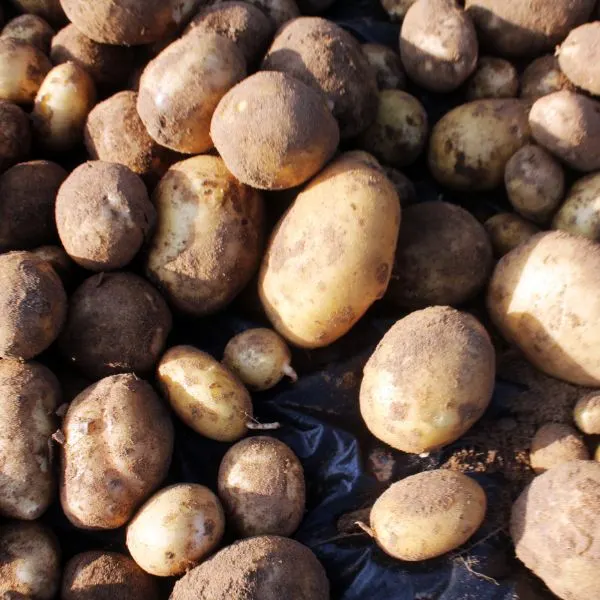
The potato is a root vegetable and a fruit that is indigenous to the Americas.
It is a starchy tuber of the plant Solanum tuberosum.
There are many methods to prepare potatoes, including whole or sliced up, skin-on or peeled, with or without spices.
Potatoes and Basil grow nicely together. Basil is thought to promote a stronger root system in potatoes and increase tuber production.
When in bloom, potatoes also draw pollinators like bees and butterflies.
However, Basil enhances the development of the potato crop.
This companion herb will not only contribute to a robust and healthy potato crop, but it will also enhance your Garden’s aesthetics and provide a savory herb choice.
Together, Basil and potatoes not only taste excellent but also grow well.
However, selecting the right fertilizer for the plants is a crucial step.
Basil requires a fertilizer that is more nitrogen-based than potatoes, which needs a fertilizer that has a larger proportion of potassium and phosphorus than nitrogen.
25. Radishes
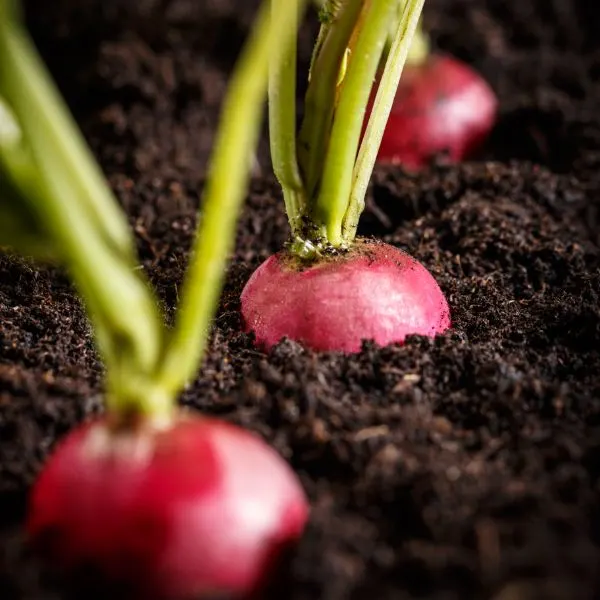
Radish is an edible root vegetable of the Brassicaceae family.
The taproot is the most typically consumed component; however, the tops can be used as a leaf vegetable, and the entire plant is edible.
Radishes may be used as markers for Basil because of how quickly they grow.
Radishes are a good companion plant for Basil because their strong aroma keeps nuisance insects, including cucumber beetles, aphids, tomato hornworms, squash bugs, and ants, away.
Additionally, they can serve as a trap crop, drawing insect pests away from your basil plant.
26. Tomatoes
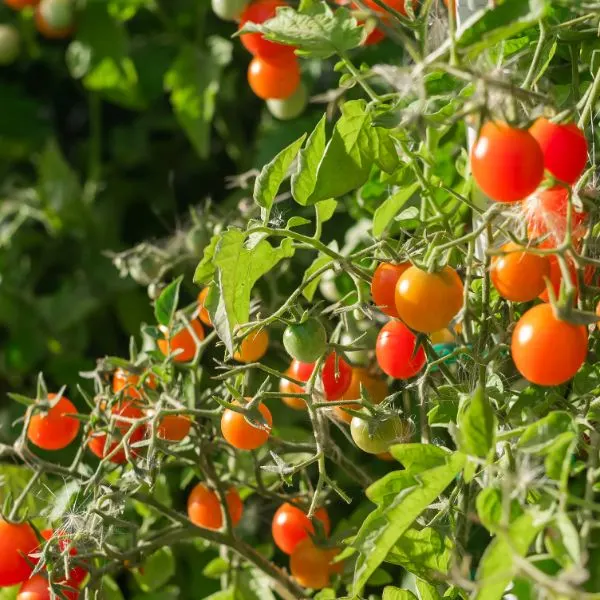
The tomato is an edible berry that is produced by the Solanum Lycopersicum plant, sometimes referred to as the tomato plant.
Tomatoes are considered vegetables in culinary terms, while their fruit is categorized as a berry in botanical ones.
It may be prepared in a variety of ways, such as fresh in salads or in slices, stewed, added to a huge range of recipes, or made into ketchup or tomato soup.
Basil is an excellent insect repellent, especially for whiteflies, aphids, thrips, and tomato hornworms.
Additionally, because they both complement each other so well in some meals, growing these two together speeds up the harvesting process.
Additionally, when planted together, Basil has been demonstrated to improve the productivity of tomato plants.
The same conditions, such as bright sunlight and well-drained soil, are favorable for both plants.
Not enough study has been done to demonstrate that Basil has any discernible effect on the flavor of the tomatoes.
But since they think it enhances the taste of ripe tomatoes, the majority of gardeners also grow Basil alongside tomatoes.
27. Turnip

The turnip sometimes called the white turnip (Brassica rapa subsp. rapa), is a root vegetable that is widely cultivated in temperate regions of the world for its white, meaty taproot.
Turnip greens, or turnip leaves, are occasionally consumed.
Basil is a great trap crop for turnips, and both plants need about the same amount of water. making it an excellent companion plan.
Bad Companion Plants for Basil
1. Cucumber
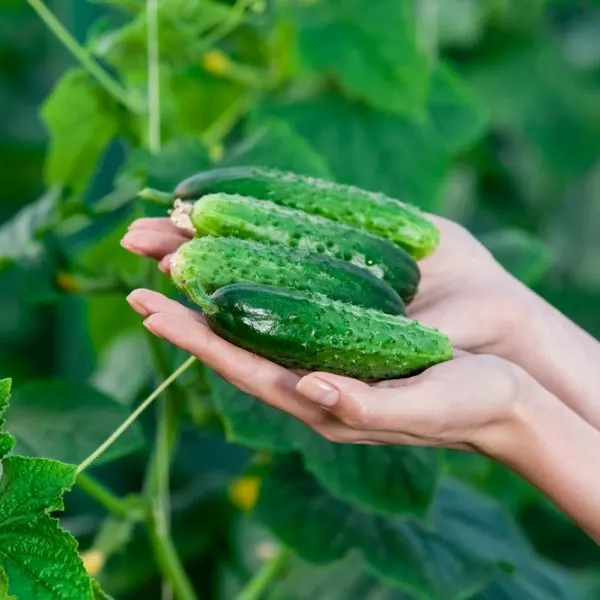
Since cucumbers are mainly water, they frequently pick up the flavor of nearby crops.
It’s preferable to put aromatic plants like Basil separately from cucumbers since their flavor might be influenced.
When cucumbers are grown close to fragrant plants, some gardeners also notice lower yields.
Basil does not do well with cucumbers because they compete with one another for resources like water and nutrients.
Basil and cucumbers will fight for soil moisture and minerals as cucumbers are both thirsty and heavy eaters.
2. Mint
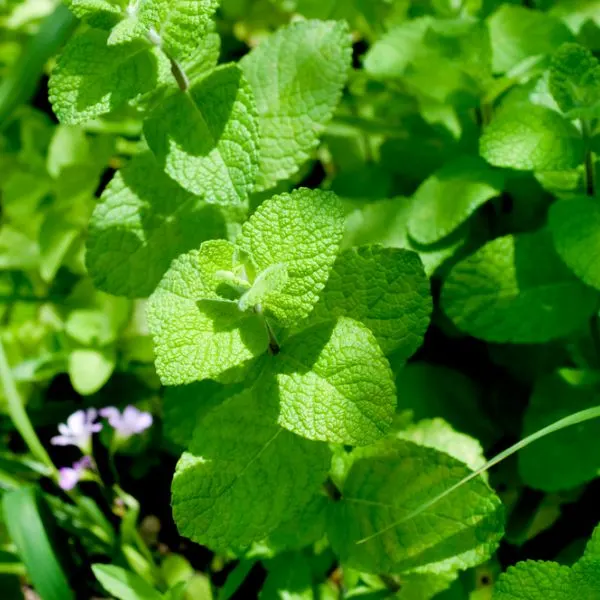
Basil will have no nutrients at all since mint is a strong feeder that will use all the soil’s nutrients.
Mint is also quite invasive and will rapidly smother your Basil and other plants in your veggie Garden.
Mint should only be planted in pots where it can be readily confined because of this.
If you grow it in the same garden bed as your Basil, it is a bad companion.
3. Fennel
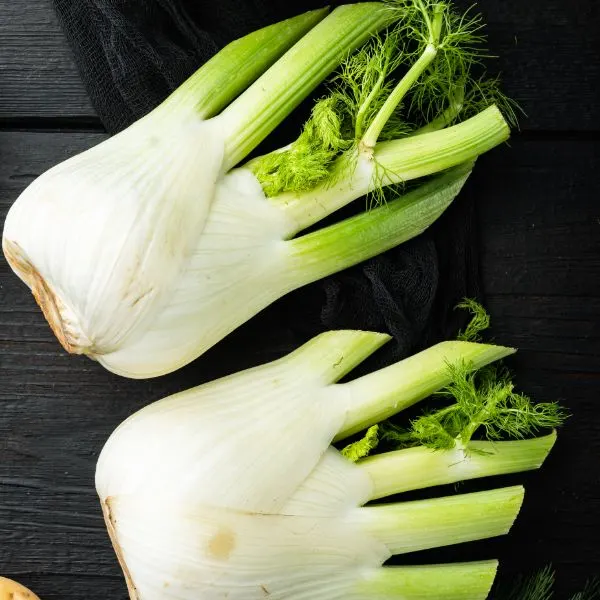
Fennel is one of the plants that doesn’t get along well with other plants, like Basil.
Basil is one of the numerous plants whose development is thought to be constrained by fennel.
The goal of companion planting is completely at odds with the fact that fennel is also known to draw some pests.
The best way to grow fennel is alone. Most other plants often have considerable growth inhibition due to it.
Despite being rather simple to cultivate, it is typically not planted for this reason.
4. Rue
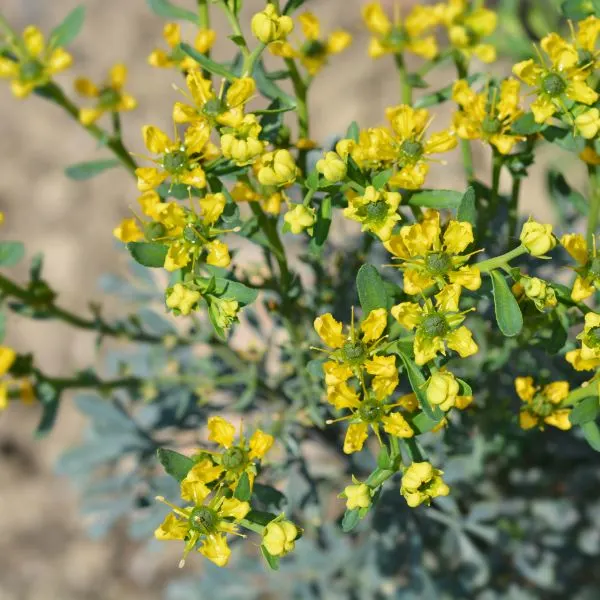
Basil plants should not be grown together since common rue is known to inhibit their development.
It accomplishes this by producing toxins from its roots that can prevent your Basil from growing.
Additionally, it may alter the flavor of your basil plant and increase its susceptibility to pests and illnesses.
5. Thyme
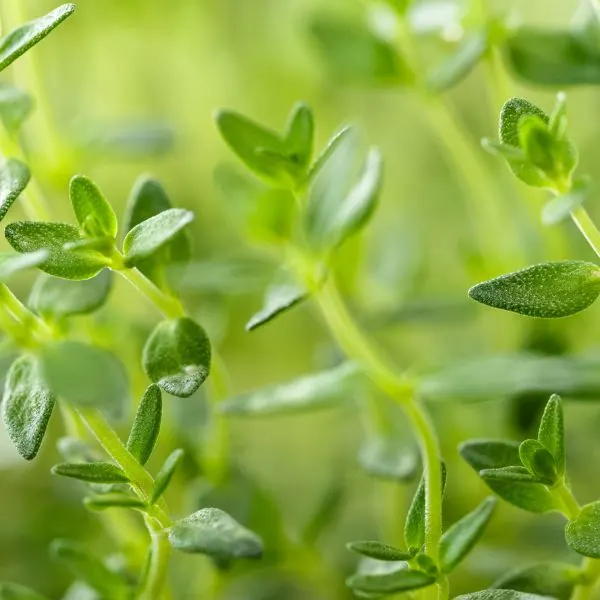
Basil and thyme don’t mix well since their preferred growth environments differ.
While Basil prefers a lot of moisture, thyme does well in sandy soil that dries up rapidly.
Therefore Thyme is a Bad Companion of Basil.
6. Sage
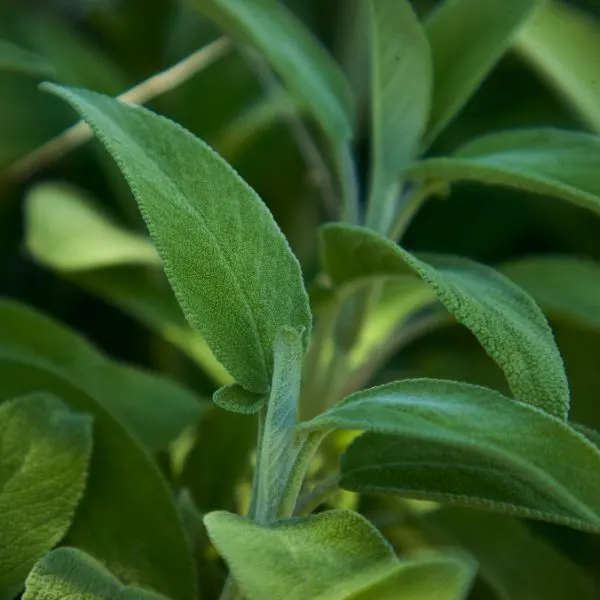
Another herb you shouldn’t grow next to Basil is sage since it requires different growth conditions than Basil.
In contrast to Basil, it greatly prefers a drier climate for growth.
Consequently, it is not advisable to cultivate these two together.
Video of the Top 12 Basil Companion Plants
FAQs
What can be potted with Basil?
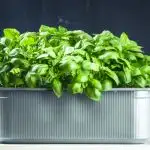
Whiteflies, mosquitoes, spider mites, and aphids are thought to be repulsive to it in the Garden.
Along with lettuce, purslane, tomatoes, and peppers, plant basil.
Basil goes nicely with tomatoes, peppers, eggplants, and zucchini in the kitchen.
Does Basil like direct sunlight?

Warm weather and direct early sunlight are ideal for basil growth.
Pick a spot that receives lots of sunshine.
Try to provide your Basil with some light shade during the warmest part of the day if you reside in a region with blistering noon heat.
Does Basil get rid of mosquitoes?

As one of the most aromatic plants, it’s easy to see why Basil enters the list of natural mosquito repellents.
It makes sense because Basil is renowned for being the ideal tomato companion plant that deters insects.
Are coffee grounds good for basil plants?

Yes, Basil and other plants may safely use coffee ground fertilizer.
Just use it sparingly once more. The nitrogen boost that coffee grounds offer to herbs is undeniable.
How do I keep my basil plant bushy?

The following advice will enable you to develop large, bushy basil plants finally.
Keep them warm, provide proper drainage, maintain moist soil, water the soil rather than the leaves, allow the plant to receive adequate sunlight, fertilize the soil appropriately, harvest them frequently and early, and make sure you prune them properly.
What does it mean when your Basil starts to flower?

These lovely blooms are a reminder that the plant is closing down and entering reproduction mode rather than growth mode.
It would produce the basil leaves I need to satisfy my pesto desires.
It’s merely a natural part of the cycle and not an indication that you did anything wrong.
Wrapping up
Basil (Ocimum basilicum) is a member of the Lamiaceae family of culinary herbs (mints).
And we have been able to know that Basil has some excellent companion plants, Twenty Seven(27) of them, and also other Six(6) plants that should not be planted near it in the Garden.
Basil contains vitamin A, vitamin C, vitamin D, iron, 4.42 mg of calcium, and potassium.
Sweet Basil has a high concentration of the chemical agent eugenol.
This gives it a clove-like scent. Basil’s eugenol can inhibit calcium channels, which may assist in decreasing blood pressure.
The essential oils in the plant can help decrease your cholesterol and triglycerides.
Basil also includes magnesium, which can aid in enhancing blood flow by relaxing muscles and blood vessels.
Basil is sensitive to cold, with the best growth in hot, dry conditions. It behaves as an annual if By chance of a frost occurrence.
Although Basil grows best outdoors, it can also be grown indoors in a pot and, Just like most herbs, will do best when placed on a sun-facing windowsill, kept away from extremely cold drafts.
Check out more types of things
